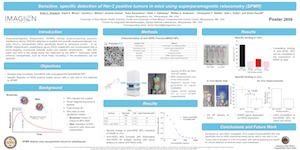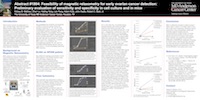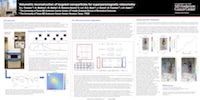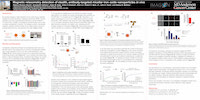This year’s Annual Meeting of the American Association for Cancer Research was held April 1-5 in Washington, D.C. The theme of this year’s meeting was “Research Propelling Cancer Prevention and Cures,” and Imagion Biosystems was pleased to have a strong presence with presentations describing recent advances in magnetic relaxometry (MRX) technology. Imagion Biosystems and the company’s research collaborators at the MD Anderson Cancer Center and the University of New Mexico presented six posters in all, covering specific advances in the application of MRX technology to earlier cancer detection.
Breast Cancer
 Superparamagnetic nanoparticles detected by MRX must remain in blood circulation long enough to encounter and attach to tumor target(s), and remain bound to permit detection by MRX before being removed by the body’s normal blood-clearing processes. Data from the poster “Sensitive, specific detection of Her2 positive tumors in mice using superparamagnetic relaxometry (SPMR)” indicate that anti-Her2 antibody conjugated PrecisionMRX™ nanoparticles can, in fact, maintain a long circulating half-life and bind specifically to Her2 positive tumors. (download pdf)
Superparamagnetic nanoparticles detected by MRX must remain in blood circulation long enough to encounter and attach to tumor target(s), and remain bound to permit detection by MRX before being removed by the body’s normal blood-clearing processes. Data from the poster “Sensitive, specific detection of Her2 positive tumors in mice using superparamagnetic relaxometry (SPMR)” indicate that anti-Her2 antibody conjugated PrecisionMRX™ nanoparticles can, in fact, maintain a long circulating half-life and bind specifically to Her2 positive tumors. (download pdf)
Ovarian Cancer
 Most ovarian cancers are diagnosed in a late, incurable stage, note the MD Anderson authors of the poster “Feasibility of magnetic relaxometry for early ovarian cancer detection: Preliminary evaluation of sensitivity and specificity in cell culture and mice.” In their study, they reported that anti-Her2-coated nanoparticles can be used with MRX to detect two types of ovarian cancer cells (SKOV3 and HEY). The authors found a strong correlation between the number of cancer cells present in cell culture, or in mice, and the intensity of the MRX signal generated. They will now proceed to expand the study to include nanoparticles coated with other ovarian-cancer targeting antibodies. (download pdf)
Most ovarian cancers are diagnosed in a late, incurable stage, note the MD Anderson authors of the poster “Feasibility of magnetic relaxometry for early ovarian cancer detection: Preliminary evaluation of sensitivity and specificity in cell culture and mice.” In their study, they reported that anti-Her2-coated nanoparticles can be used with MRX to detect two types of ovarian cancer cells (SKOV3 and HEY). The authors found a strong correlation between the number of cancer cells present in cell culture, or in mice, and the intensity of the MRX signal generated. They will now proceed to expand the study to include nanoparticles coated with other ovarian-cancer targeting antibodies. (download pdf)
Technology Improvements
 “Enhancing the in vivo detection of cancer by manipulating magnetic fields applied to tumor targeting superparamagnetic iron oxide nanoparticles” describes our recent work to improve the sensitivity of the technology by reducing background signal ten-fold during MRX data collection. The study was performed using nanoparticles targeted against breast cancer cells, but the technological improvements are applicable to all forms of cancer detection by MRX. (download pdf)
“Enhancing the in vivo detection of cancer by manipulating magnetic fields applied to tumor targeting superparamagnetic iron oxide nanoparticles” describes our recent work to improve the sensitivity of the technology by reducing background signal ten-fold during MRX data collection. The study was performed using nanoparticles targeted against breast cancer cells, but the technological improvements are applicable to all forms of cancer detection by MRX. (download pdf)
 To be of greatest value as a diagnostic method, MRX technology must be able to determine whether a tumor is present and identify its approximate location in three-dimensional space. In the poster “Volumetric reconstruction of targeted nanoparticles for superparamagnetic relaxometry,” the authors describe validation of an algorithm that analyzes MRX data to determine the locations of ovarian tumors in mice without prior information regarding the expected number of tumors or their approximate locations. (download pdf)
To be of greatest value as a diagnostic method, MRX technology must be able to determine whether a tumor is present and identify its approximate location in three-dimensional space. In the poster “Volumetric reconstruction of targeted nanoparticles for superparamagnetic relaxometry,” the authors describe validation of an algorithm that analyzes MRX data to determine the locations of ovarian tumors in mice without prior information regarding the expected number of tumors or their approximate locations. (download pdf)
 “Binary Classification of Superparamagnetic Relaxometry Data for Cancer Screening” describes the development of a computational method to help oncologists determine whether a set of MRX data does, or does not, indicate the presence of a tumor. The authors achieved 96.4% classification accuracy using data collected from an artificial mouse model (phantom) where 7.3% of injected nanoparticles were accumulated at the tumor site. The authors will refine their Gaussian process model in pre-clinical studies. (download pdf)
“Binary Classification of Superparamagnetic Relaxometry Data for Cancer Screening” describes the development of a computational method to help oncologists determine whether a set of MRX data does, or does not, indicate the presence of a tumor. The authors achieved 96.4% classification accuracy using data collected from an artificial mouse model (phantom) where 7.3% of injected nanoparticles were accumulated at the tumor site. The authors will refine their Gaussian process model in pre-clinical studies. (download pdf)
 The production and characterization of a new form of molecular-specific iron oxide nanoparticles is described in “Magnetic relaxometry detection of stealth antibody-targeted micellar iron oxide nanoparticles in vivo.” The nanoparticles were stable in various biological media, including human plasma, and capable of circulating in the blood of healthy mice for more than two hours. The authors also presented a chemical method of attaching epidermal growth factor receptor antibodies to the nanoparticles, which could enable the targeting and detection of numerous epithelial cancers, such as esophageal, colon, bladder, and lung carcinomas. (download pdf)
The production and characterization of a new form of molecular-specific iron oxide nanoparticles is described in “Magnetic relaxometry detection of stealth antibody-targeted micellar iron oxide nanoparticles in vivo.” The nanoparticles were stable in various biological media, including human plasma, and capable of circulating in the blood of healthy mice for more than two hours. The authors also presented a chemical method of attaching epidermal growth factor receptor antibodies to the nanoparticles, which could enable the targeting and detection of numerous epithelial cancers, such as esophageal, colon, bladder, and lung carcinomas. (download pdf)
Phase 2 HER2 Clinical Trial Manufacturing Commenced, WSU Imaging Optimisation Program Underway
Highlights Dr Nina Webster appointed as IBX Non-Executive Director, bringing significant clinical development expertise and corporate experienceto the IBX Board ahead of HER2 Breast cancer

